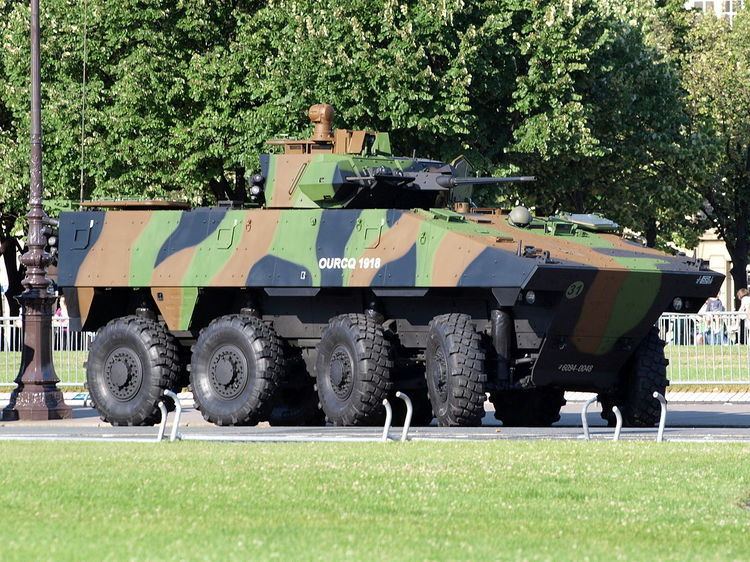Place of origin France | Produced 2008-2015 (planned) | |
 | ||
Type Infantry fighting vehicle Wars War in Afghanistan
Operation Serval Manufacturer Giat Industries / Renault VI Unit cost €3.49m (VCI, FY2012)
€2.74m (VPC, FY2012) | ||
The Véhicule Blindé de Combat d'Infanterie (VBCI, "Armoured vehicle for infantry combat") is a French Infantry fighting vehicle designed to replace the AMX-10P. They entered active service with the French Army in 2008, with 630 vehicles ordered up to 2010. Other countries like Spain and the UK have shown interest in the vehicle.
Contents
The Véhicule Blindé de Combat d'Infanterie is built on an aluminium hull which carries a modular THD steel and titanium armour, which can be replaced in the field. The 8x8 wheel combination is designed to make the VBCI more comfortable and less costly than a tracked vehicle, while giving it sufficient mobility to back the Leclerc tank. The VBCI is also designed to be transportable by the Airbus A400M, with an empty mass less than 18 tonnes (full load mass up to 28 tonnes).
History
In the early 1990s, the French government started the VBM (Véhicule Blindé Modulaire — Modular Armoured Vehicle) as a replacement for its older IFVs. Soon, Germany and the United Kingdom joined the project. At Eurosatory 1996, Renault unveiled the X8A, an eight-wheeled prototype in this erspective.
However, in 1999, the programme came to a dead-end, and France decided to carry on on its own and ordered 700 vehicles on 6 November 2000. In 2003-2004, the programme reached some major milestones: The mobility/agility tests, the armour tests and the electronic systems tests were all successful. From 2004 to 2005, the first 5 prototypes (4 VCIs and 1 VPC) were tested in real conditions. These tests proved some crucial design mistakes on the DRAGAR turret, which had to be redesigned. The 2 years delay in the programme are consequences of this design flaw.
As the programme reaches completion, other versions are being studied. A mortar version and a vehicle using the MILAN Missile have been considered by the developer. Note that none of these versions are being developed as of now, but feasibility studies are being conducted. In June 2007, VBCI was being considered for the British FRES programme.
France originally planned to buy 550 VCI and 150 of the VPC command version, but this was cut to 510 and 120 respectively with deliveries until 2015. The €3.49bn (FY2012) project will deliver 630 units at a unit cost of €3.49m (~US$4.8m) for the VCI and €2.74m (~US$3.7m) for the VPC, or €5.5m (~US$7.4m) per vehicle including development costs.
The 200th VBCI was delivered to the French army on 23 June 2010. The 400th VBCI was delivered to the French army on 12 June 2012. The first unit to be equipped with the new infantry fighting vehicle was the 35th Infantry Regiment in Belfort. The 500th VBCI was delivered to the French Army on 8 July 2013. Delivery of 110 command post vehicles has been completed.
At Eurosatory 2014, Nexter unveiled improvements to the VBCI IFV variant following trials. The rear wheels have steering to reduce its turning radius to 20 meters, and rear internal volume was increased by moving electrical equipment to the front of the vehicle. To make room for the equipment, the driver's seat was pulled back and two sloping angles were added to the front end for the driver to maintain visibility. In September 2014, the French Army Procurement Agency (DGA) declared the qualification of a new version of the VBCI with a 32-ton gross vehicle weight, compared to 29 tons previously. The increase in gross weight allows the vehicle to have better protection and preserves its capability to be upgraded. The 32-ton configuration will be delivered to the French armed forces starting in 2015.
Export
In February 2014, France agreed to lend a few VBCIs to the British Army for testing. French military sources report that the British Army is interested in purchasing the vehicle. The French Ministry of Defense has indicated that the French Army may purchase the British Watchkeeper WK450 unmanned aerial vehicle if the British Army buys the VBCI. The British Army is testing the VBCI as part of the future Mechanised Infantry Vehicle program, intended to start replacing the current fleet of protected mobility vehicles by 2022.
Versions
Common features for all versions include SIT (Système d’Information Terminal) communication equipment, combat identification equipment, and NBC detection and protection equipment.
C4ISR
The VBCI will be completely integrated in the French C4ISR capability. The VCI version will use the SIT (Système d’Information Terminal — The lowest level of C4IST in the French forces), while the VPC will use the SIR (Système d’Information Régimentaire — A higher level in the same system).
The vehicle will be designed to primarily carry soldiers equipped with the FÉLIN system.
DRAGAR Turret
The DRAGAR Turret (GIAT INDUSTRIES) is a single seat modular design turret integrating a 25 mm stabilized gun. Fire control integrates a laser telemeter and a thermal camera. The rate of fire is up to 400 rounds/min, and the turret allows anti-air self-defence. It also includes a coaxial 7.62 mm machine gun for close defence and a Galix grenade launching system.
